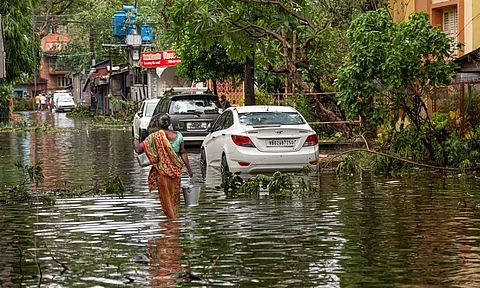

Warm subsurface waters in the Bay of Bengal likely helped fuel the 2020 Amphan super cyclone, a new study has suggested.
Additionally, warmer surface waters may have also helped sustain marine heatwaves — prolonged high sea temperatures. Marine heatwaves also likely helped intensify the cyclone from Category 1 (cyclonic storm) to Category 5 (super cyclone) in less than 36 hours, the study published in Frontiers in Climate, reported.
Amphan was the first super cyclone in the Bay of Bengal in the last 21 years. It was also the costliest tropical cyclone on record in the North Indian Ocean, with reported economic losses of approximately $14 billion in India, according to the World Meteorological Organization.
Read Down To Earth’s coverage of super cyclone Amphan
“Cyclones are an extreme event, and so are marine heat events. We wanted to look at how the two events interacted and supported each other,” Saurabh Rathore, the lead author from LOCEAN-IPSL Sorbonne University, Paris, told Down To Earth.
Researchers from France, Australia and India investigated the events that led to the formation of the Amphan super cyclone.
They collected data on the temperature of the water at the ocean surface or the sea surface temperatures, subsurface warming and data on the cyclone trajectory.
The researchers divided the Bay of Bengal basin into two: Box 1 covering the southern part and Box 2 covering the northern portion. A marine heatwave appeared in the southern part of the Bay of Bengal basin from May 1, 2020, to May 17, 2020 and on the northern portion from May 6, 2020 to May 19, 2020, the researchers noted.
During this time, the sea surface temperature in the southern and northern portions was close to 1.5 and 2°C above the average of 30.2 and 29.7°C, respectively, the study noted.
A strong marine heatwave covered close to 300,000 square kilometres area of the basin, the study highlighted.
Cyclone formation, according to the team, began May 16 2020 in the southern portion, before reaching the northern part May 20, 2020. The team also looked at warming in the subsurface, which is 20 meters below the surface waters.
The heat content in the subsurface ranged between 135 and 150 kilojoules per square centimetre before the cyclone, according to the findings.
Warm subsurface waters could intensify cyclones by allowing heat to flow between the sea and atmosphere, the study explained. Warmer waters fuel cyclones, experts have said.
The subsurface water may have warmed because of the high sea level anomaly, which is the difference between the total and average sea level, Rathore said.
“An increase in sea level is brought about by anticyclonic eddies, which is a circular movement of water,” Rathore added.
The sea temperatures cooled as the cyclone approached the coast. Subsurface warming also went down, bringing the marine heatwave event to a close, the report stated.
Rathore’s team found another marine heatwave re-emerging 15 days after Amphan made landfall.
“The study shows a link between marine heatwaves and cyclones,” Abhisek Chatterjee, Scientist at the Hyderabad-based Indian National Centre for Ocean Information Services, told DTE. He was not involved in the study.
Chatterjee found a similar pattern arising in the Arabian Sea. “The current evidence suggests that prolonged heatwaves could act as indicators of cyclones,” he explained. “However, more studies are needed to confirm this link between marine heatwaves and cyclones,” he added.
“We only looked at oceans in this study,” Rathore said. “Future studies can evaluate how the atmosphere helps marine heatwave fuels cyclones,” he added.